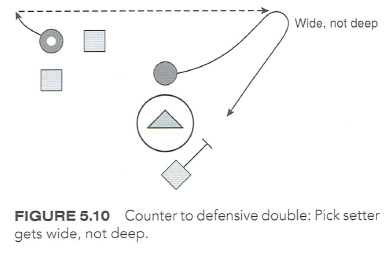|
Three-Cone Pick Timing Drill By: Don Zimmerman and Peter England Provided by: Human Kinetics
SETUP EXECUTION COACHING POINTS
Field Position Offensive Reaction to Defensive Pick Strategy Defenses will attempt to neutralize the effects of an on-ball pick by either sliding through the pick and staying on their man, switching on the pick, or doubling the pick, especially if a midfielder sets a pick for an attackman. Most teams want to stay on their matchups (each defender stays on his assigned attacker). College teams will assign defenders to specific opposing offensive players based on agility, speed, strength, intelligence, and so on. However, if you set an effective pick, the defense will have to adjust and switch. In this situation, a switch is reactive in nature because the defense has no other choice. On the other hand, a switch or double can be actively used as a tactic to neutralize the pick. Counter to Defensive Switch Counter to Defensive Double If you are the pick user, you must have your head on a swivel so you can use your peripheral vision to look for both defenders and the open pick setter. You should turn and sprint away from the defensive pressure. You want Wide, not deep to run from the two defenders at a 45-degree angle and run to daylight (an open area). You don't want to "corkscrew," which means turning into the defensive double team. You need to get your hands free so you can make a quick pass. In general, defenders are taught FIGURE 5.10 Counter to defensive double: Pick setter to stay on doubles. If both gets wide, not deep. defenders stay on the double team, you want to carry both defenders away from the goal. The farther you carry the two defenders away from the goal, the longer it will take them to recover. If both defenders are committed to you, then you're not in a hurry to pass the ball. Be quick to escape, but don't hurry to pass. You want to continue to carry them for as long as you need to because your team will have a two-on-one advantage somewhere. If the blind-side defender leaves you, you should make a quick pass because the ball will move faster than the defender can recover, and you might still be able to take advantage of the defense's overaggressive play. As the pick setter versus a double, you should get wide, not deep. If you run parallel to the end line and get wide, you will be more of an offensive threat. You want to position yourself to get the ball and maintain the man-up advantage. Ideally, you should split your original defender and the next sliding defender. You don't want your original defender to be able to recover to you, and you don't want to shorten the slide of the next sliding defender. The pick user is making a 15-yard pass no matter what, and you just have to make it to the optimum spot. If you run to the end line and get too deep, you're going away from the goal, and your original defender can successfully recover and beat you to the GLE. By getting too deep, you allow your original defender to "play two": The defender doubles the pick user and recovers to play the pick setter. Remember, you should never allow a defender to play two offensive players.
|









